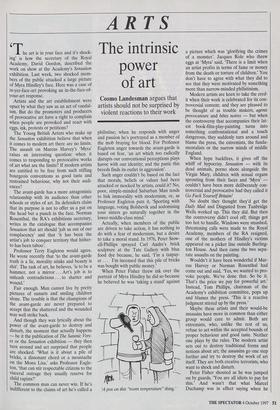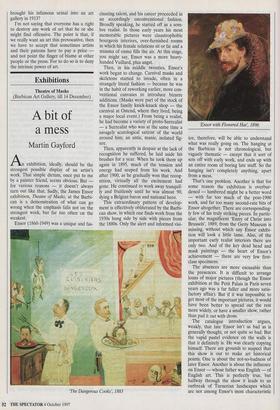ARTS
The intrinsic power of art
Cosmo Landesman argues that artists should not be surprised by violent reactions to their work
The art is in your face and it's shock- ing' is how the secretary of the Royal Academy, David Gordon, described the work on show at the Academy's Sensation exhibition. Last week, two shocked mem- bers of the public attacked a large picture of Myra Hindley's face. Here was a case of in-yer-face-art provoking an in-the-face-of- your-art response. Artists and the art establishment were upset by what they saw as an act of vandal- ism. But do the promoters and producers of provocative art have a right to complain when people are provoked and react with eggs, ink, protests or petitions? The Young British Artists who make up the Sensation exhibition believe that when it comes to modern art there are no limits. The assault on Marcus Harvey's 'Myra' raises an interesting question: when it comes to responding to provocative works of art what are the limits? If modem artists are entitled to be free from such stifling bourgeois conventions as good taste and restrained behaviour, why not their audi- ences?
The avant-garde has a more antagonistic relationship with its audience than other schools or styles of art. Its defenders claim that its purpose is not to offer us a pat on the head but a punch in the face. Norman Rosenthal, the RA's exhibitions secretary, writes in the catalogue that accompanies Sensation that art should 'jolt us out of our complacency' and that 'it has been the artist's job to conquer territory that hither- to has been taboo'.
Professor Terry Eagleton would agree. He wrote recently that `to the avant-garde truth is a lie, morality stinks and beauty is shit'. The task of art, he believes, 'is to be a hammer, not a mirror. ... Art's job is to unleash contradictions ... to shatter and wound.'
Fair enough. Man cannot live by pretty pictures of sunsets and smiling children alone. The trouble is that the champions of the avant-garde are never prepared to accept that the shattered and the wounded may well strike back.
And though they wax lyrically about the power of the avant-garde to destroy and disturb, the moment that actually happens — be it the publication of The Satanic Vers- es or the Sensation exhibition — they then turn around and act surprised that people are shocked. 'What is it about a pile of bricks, a dissonant chord or a moustache on the Mona Lisa,' asks Professor Eagle- ton, `that can stir respectable citizens to the visceral outrage they usually reserve for child rapists?'
The common man can never win. If he's indifferent to the claims of art he's called a philistine; when he responds with anger and passion he's portrayed as a member of the mob braying for blood. For Professor Eagleton anger towards the avant-garde is based on fear, 'an art which too radically disrupts our conventional perceptions plays havoc with our identity; and the panic this breeds finds its outlet in aggression'.
Such anger couldn't be based on the fact that morals, beliefs or values had been attacked or mocked by artists, could it? No, poor, simple-minded Suburban Man tends to link immorality with modernism, or, as Professor Eagleton puts it, 'Sporting with language, voting Bolshevik and sodomising your sisters go naturally together in the lower-middle-class mind.'
Actually, when, members of the public are driven to take action, it has nothing to do with a fear of modernism, but a desire to take a moral stand. In 1976, Peter Stow- ell-Phillips sprayed Carl Andre's brick sculpture at the Tate Gallery with blue food dye because, he said, 'I'm a taxpay- er .. I'm incensed that this pile of bricks was bought with public money.'
When Peter Fisher threw ink over the portrait of Myra Hindley he did so because he believed he was 'taking a stand' against 'A pox on this "room temperature" thing.' a picture which was 'glorifying the crimes of a monster'. Jacques Role who threw eggs at 'Myra' said, 'There is a limit when an artist profits in terms of fame or money from the death or torture of children.' You don't have to agree with what they did to see that they were motivated by something more than narrow-minded philistinism.
Modern artists are keen to take the cred- it when their work is celebrated for its con- troversial content; and they are pleased to be thought of as trouble makers, agents provocateurs and bites noires — but when the controversy that accompanies their lat- est book-film-play-painting turns into something confrontational and a touch dangerous, they suddenly turn around and blame the press, the extremists, the funda- mentalists or the narrow minds of middle England.
When hype backfires, it gives off the whiff of hypocrisy. Sensation — with its dead animals, porno shots alongside the Virgin Mary, children with sexual organs sprouting from their faces and 'Myra' — couldn't have been more deliberately con- troversial and provocative had they called it Go Fuck Yourself Britain!
No doubt they thought they'd get the Daily Mail and Disgusted from Tunbridge Wells worked up. This they did. But then the controversy didn't cool off; things got too hot to handle. Windows were smashed, threatening calls were made to the Royal Academy, members of the RA resigned, one of the mothers of Hindley's victims appeared on a picket line outside Burling- ton House. And then came the two sepa- rate assaults on the painting.
Wouldn't it have been wonderful if Mar- cus Harvey or Norman Rosenthal had come out and said, 'Yes, we wanted to pro- voke people. We've done that. So be it. That's the price we pay for powerful art.' Instead, Tom Phillips, chairman of the Academy's exhibition committee, pops up and blames the press. 'This is a reactive judgment stirred up by the press.'
Maybe these artists and their would-be assassins have more in common than either group would care to admit. Both are extremists, who, unlike the rest of us, refuse to act within the accepted bounds of proper behaviour and good taste. Neither one plays by the rules. The modern artist sets out to destroy traditional forms and notions about art; the assassins go one step further and try to destroy the work of art itself. They are both creative terrorists, who want to shock and disturb.
Peter Fisher shouted as he was jumped on by guards, 'You are all idiots to pay for this.' And wasn't that what Marcel Duchamp was in effect saying when he brought his infamous urinal into an art gallery in 1913?
I'm not saying that everyone has a right to destroy any work of art that he or she might find offensive. The point is that, if we really want an art this provocative, then we have to accept that sometimes artists and their patrons have to pay a price — and not point the finger of blame at other people or the press. For to do so is to deny the intrinsic power of art.











































































 Previous page
Previous page